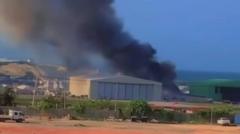An Ugandan military helicopter performing a routine combat escort mission crashed on September 29 at Aden Adde International Airport in Mogadishu, igniting a fire that tragically claimed the lives of five individuals aboard. Meanwhile, the pilot, co-pilot, and flight engineer sustained serious injuries and severe burns, as confirmed by Ugandan military spokesperson Maj Gen Felix Kulaigye.
Witness Farah Abdulle recalled hearing an explosive blast followed by a surge of smoke and flames enveloping the helicopter. Emergency services quickly contained the fire, averting further chaos at the airport. Notably, operations for domestic flights remained unaffected, although the crash delayed a departing Turkish Airlines flight.
The helicopter originated from Balidogle airbase in Lower Shabelle, situated approximately 56 miles north-west of Mogadishu, according to feedback from Ahmed Maalim, the head of Somalia's Civil Aviation Authority. The incident is particularly concerning as Ugandan troops contribute to an 11,000-member African Union force combatting the al-Qaeda-linked al-Shabab insurgent faction that has perpetuated violence in Somalia for over 20 years.
An investigation into the crash is currently underway, aiming to ascertain the causes behind this unfortunate incident. This event has reignited discussions on aviation safety and operational protocols during military missions, underscoring the pressing need for stringent regulations and improved safety measures in conflict zones.
Witness Farah Abdulle recalled hearing an explosive blast followed by a surge of smoke and flames enveloping the helicopter. Emergency services quickly contained the fire, averting further chaos at the airport. Notably, operations for domestic flights remained unaffected, although the crash delayed a departing Turkish Airlines flight.
The helicopter originated from Balidogle airbase in Lower Shabelle, situated approximately 56 miles north-west of Mogadishu, according to feedback from Ahmed Maalim, the head of Somalia's Civil Aviation Authority. The incident is particularly concerning as Ugandan troops contribute to an 11,000-member African Union force combatting the al-Qaeda-linked al-Shabab insurgent faction that has perpetuated violence in Somalia for over 20 years.
An investigation into the crash is currently underway, aiming to ascertain the causes behind this unfortunate incident. This event has reignited discussions on aviation safety and operational protocols during military missions, underscoring the pressing need for stringent regulations and improved safety measures in conflict zones.


















